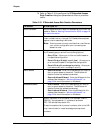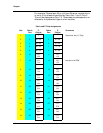
9-34 Avaya P550R, P580, P880, and P882 Multiservice Switch User Guide, v5.3.1
Chapter
■ Enable Routing at the Module
■ Design Safe, Efficient ACLs
■ Identify the Ports
■ Configure Hash Mode
■ Manage F-Chip memory
■ Manage Cache Timers
Recognize
Performance
Issues
When the ACL is the root of a performance problem, it shows as the
Slow Path becoming overused. The Slow Path is not designed to
handle significant traffic levels since the single CPU also handles all
other management functions. There are several ways to determine if
the CPU is overloaded:
■ Continuous PING to the supervisor: timeouts or inconsistent
timing of echo responses.
■ Slow Scrolling LED Marquee: This is good visual sign that the
CPU is busy.
■ Slow Management response: If Avaya Multiservice Network
Manager (MSNM), Avaya Policy Manager (APM), HPOV, or
a MIB browser get slow updates, this can signify a busy CPU
or saturated network.
■ Slow network response: This can be measured in a variety of
ways.
Once you have determined that the ACL is the root cause, and have
optimized the rules, you need to tune system parameters.


















